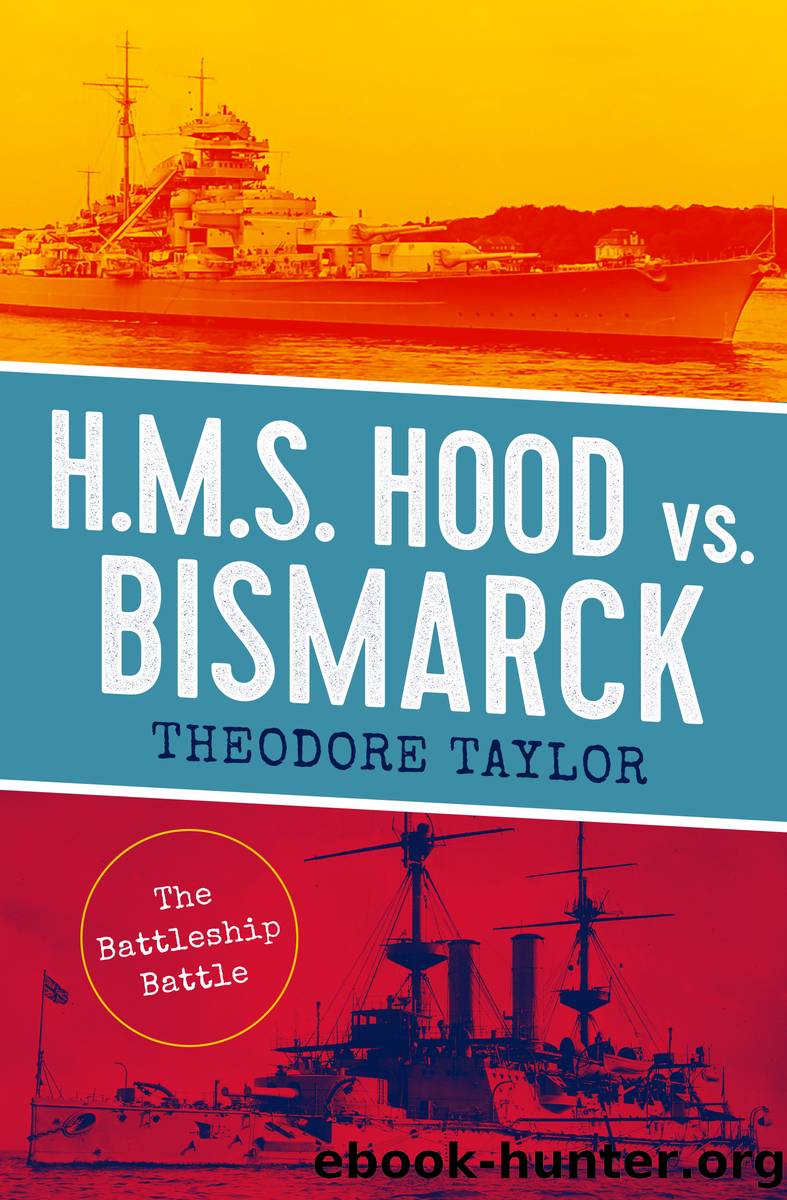H.M.S. Hood vs. Bismarck by Theodore Taylor

Author:Theodore Taylor
Language: eng
Format: epub
Publisher: Open Road Media
Published: 2022-10-15T00:00:00+00:00
12. An Air Strike Is Planned
Since early morning, Admiral Tovey, being a realist, has considered the possibility of the Bismarck escaping completely. He is now aware of the trail of fuel behind her, indicating damage, but does not take much stock in the oil slick. A tiny leak can spread a film a hundred yards wide for miles.
Tovey knows only too well, from the shadowing reports, that the Bismarck can still steam at 28 knots, and if weather worsens during the night Lütjens can rather easily slip away from that pulsing arm of radar. Once lost to the trackers, the battleship has every chance of going far into the Atlantic and evading every ship sent after it.
Fuel is also a large factor with Toveyâs own ships. There are no British tankers out here to refuel them, and at a certain point all of them will have to head for a port, Bismarck and revenge beside the point. Battleships and carriers require vast amounts of oil to keep operating.
Tovey finally decides, in early afternoon, that his only chance of ever catching the Bismarck is to hit it from the air; cripple it. With Lütjens still on his southerly course, torpedo planes from the Victorious will be in reach by 9 P.M.
The Victorious, a new carrier, is not really ready for combat air operations. Until Tovey nominated her for possible action against the Bismarck, she was under orders to sail from Scapa Flow to Gibraltar with a cargo of dismantled Hurricane fighter aircraft. But on the hangar deck are nine Fairey Swordfish torpedo planes and six Fairey Fulmars, single-wing carrier fighters.
Airmen assigned to these planes have only been aboard little more than a week, have not had time to operate as a squadron, and none have ever made night landings on the Victorious. No matter these deficits, they are all that Tovey has at present. Force H and the Ark Royal are hundreds of miles away.
Known to British aviators as âStringbags,â the Swordfish torpedo biplanes already seem out of place in a war that will introduce jet engines and the atomic bomb. The open-cockpit Swordfish, with a crew of three, is canvas covered, which is really an advantage. Bullets pass through the cloth, sometimes leaving the aircraft in âstrings.â Easy to maneuver, they have a remarkable survival rate. One was flown home with an entire wing blown off.
The Stringbags have already distinguished themselves in Mediterranean combat, credited with sinking more than a dozen Italian warships at the battles of Taranto and Matapan. Theyâve also downed enemy ships in the English Channel. Looking flimsy and antique, they possess a deathly sting.
Download
This site does not store any files on its server. We only index and link to content provided by other sites. Please contact the content providers to delete copyright contents if any and email us, we'll remove relevant links or contents immediately.
Pale Blue Dot by Carl Sagan(4912)
Cracking the GRE Premium Edition with 6 Practice Tests, 2015 (Graduate School Test Preparation) by Princeton Review(4224)
Pocahontas by Joseph Bruchac(4182)
Unfiltered by Lily Collins(3958)
The Emotionary: A Dictionary of Words That Don't Exist for Feelings That Do by Eden Sher(3318)
The Daily Stoic by Holiday Ryan & Hanselman Stephen(3235)
Factfulness_Ten Reasons We're Wrong About the World_and Why Things Are Better Than You Think by Hans Rosling(3199)
The President Has Been Shot!": The Assassination of John F. Kennedy by Swanson James L(3053)
The 48 laws of power by Robert Greene & Joost Elffers(3024)
Sapiens and Homo Deus by Yuval Noah Harari(2987)
Rogue Trader by Leeson Nick(2977)
The Innovators: How a Group of Hackers, Geniuses, and Geeks Created the Digital Revolution by Walter Isaacson(2841)
Gettysburg by Iain C. Martin(2780)
The Rape Of Nanking by Iris Chang(2774)
Almost Adulting by Arden Rose(2663)
The Plant Paradox by Dr. Steven R. Gundry M.D(2547)
In the Woods by Tana French(2533)
500 Must-Know AP Microeconomics/Macroeconomics Questions(2532)
Make by Mike Westerfield(2289)
